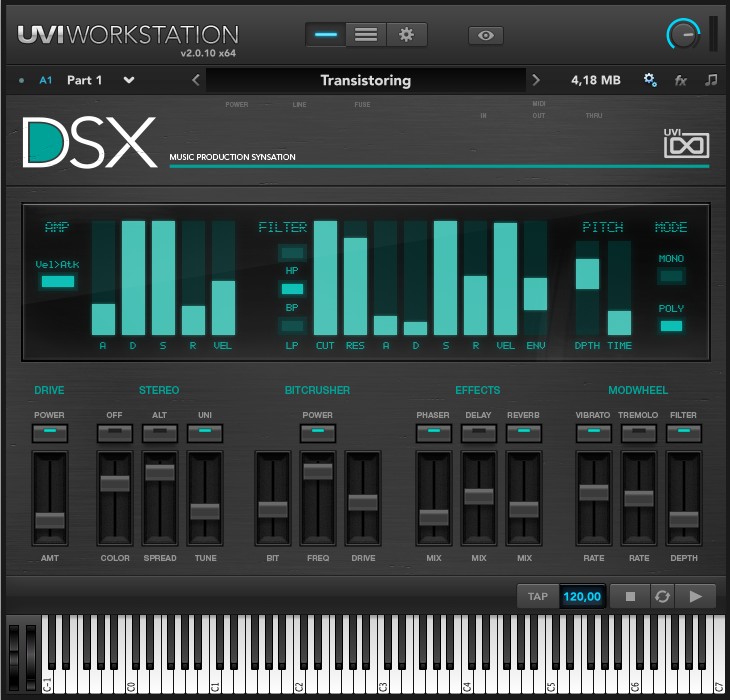

- #MINILAB UVIWORKSTATION MOD#
- #MINILAB UVIWORKSTATION PATCH#
- #MINILAB UVIWORKSTATION PORTABLE#
- #MINILAB UVIWORKSTATION PRO#
- #MINILAB UVIWORKSTATION SOFTWARE#
#MINILAB UVIWORKSTATION SOFTWARE#
Moreover, this programming takes place on a per-pad basis, so you can set things up exactly as you would like and save the settings in banks, via the software, to be recalled from one of eight locations, either from the software or the MiniLab itself, using a ‘shift-pad’ arrangement.
#MINILAB UVIWORKSTATION PATCH#
These can be configured to MIDI notes, making then very usable as drum-pad triggers, but it’s also possible to get them to trigger patch changes, which opens up a useful concept for live performance. Thanks to Arturia’s MIDI Control Centre software, you can set things up however you like, and nowhere is this more the case than with the eight drum pads. Turning our attention to the drum pads and controller pots, this is a very usable setup.
#MINILAB UVIWORKSTATION PORTABLE#
Ultimately, there’s no getting away from the fact that the MiniLab is portable and offers more than just the keybed. But personally, I can’t get on with keys of this size, whether they are slim, mini or otherwise – however, that probably has more to do with the fact that I’ve spent my entire life playing larger-key-based synths. If you’re going to look at getting MiniLab Mk II, you will doubtless walk into the agreement knowing you’re buying something with a small footprint and is this regard, it’s good value for money. Despite its ‘mini/slim’ design, it looks classic, with a sort of matt finish that reminds me of a piano. I actually quite like the general look of the keybed. In play, the keyboard feels usable, but probably due to its size, the keys spring back in quite a lively fashion, likely thanks to a reasonably heavy-duty spring inflicting the return action, but it’s got an affirmative feel that is good enough and synth-like. Apart from the USB connection, the only other jack point is for a pedal – notably sustain – should you feel you need it.
#MINILAB UVIWORKSTATION PRO#
There’s no doubt that the addition of a power input would be useful, but as we have seen elsewhere with other USB-powered products from Arturia, it seems to manage to ensure its devices to use power efficiently, and I imagine the same would be the case here (I still don’t know how the company managed to get the BeatStep Pro to output as much as it does, but hey, it works). It’s a perfect solution for a cheap and effective synth though, especially if partnered with one of Arturia’s excellent iOS-based synths, such as the iMini (Mini Moog app) or the iSEM (Oberheim app). Cleverly, it also draws power from smaller devices, if connected to an iPhone or iPad, and works pretty brilliantly, although I would imagine that the power drain on the source device might necessitate the need for some sort of power solution, so that the iOS device could also receive power, to prevent it running down during use.
#MINILAB UVIWORKSTATION MOD#
Similar to previous designs, we also have two capacitance-based pitch and mod wheels (but without the wheels, if you see what I mean) – and, given the two-octave limitation, a handy pair of buttons for shifting up and down in octave jumps.Ĭonnections are relatively basic and simple, via a singular USB connection, with the MiniLab Mk II drawing power over USB.


However, there is a 9-16 button, which will flick them over the next wave, being indicated by the illumination of the first pad. Beneath the encoders are eight programmable drum-style pads, labelled 1 to 8. This makes the pots feel different to the rest when rotated – predictably enough, because the shaft underneath is a different design. I found that notes would not trigger, because the see-saw point of the key meant that I was unable to apply enough pressure, when playing certain chords – but then, at this price point, you have to work with what you get which, on the whole, is a decent enough feel.Īlso included with the MiniLab MK II, and in line with the previous model, are 16 encoders which run in two rows across the top, with the two encoders to the far left also having a ‘button press’ action available. While generally playable, the usual issues with this type of keyboard remain, particularly as my pianistic fingers edged up the keys. The keys are described as slim, although Arturia also uses the word ‘mini’ on its website, so this might be pure semantics.


 0 kommentar(er)
0 kommentar(er)
